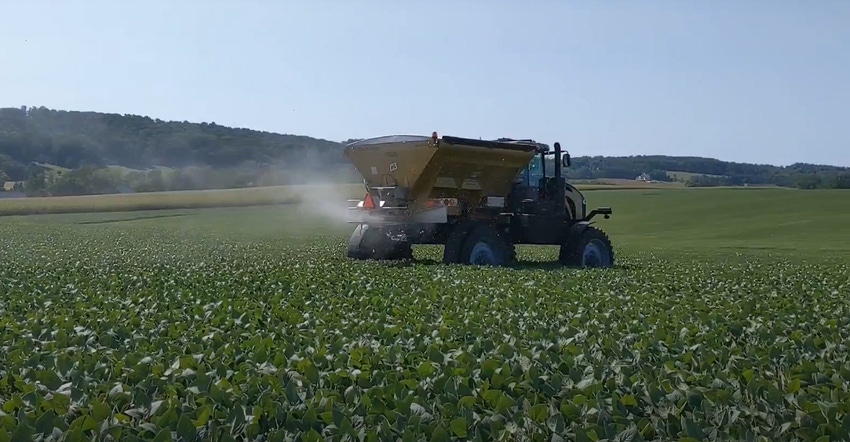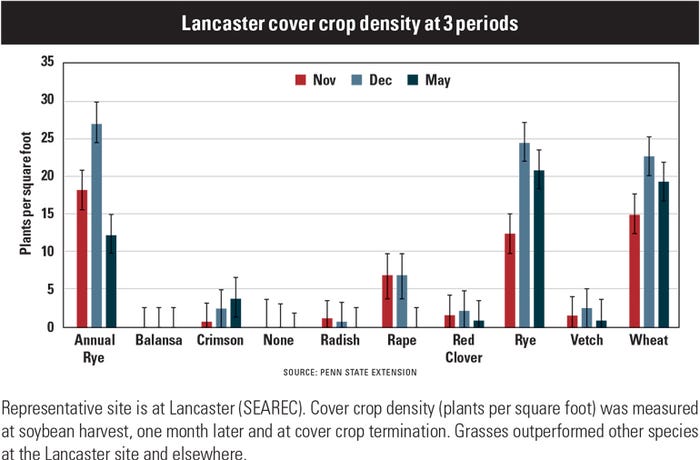September 23, 2021

The fallow period between soybean harvest and corn planting in a crop rotation is highly vulnerable to sediment and nutrient losses, but soybean harvest is often so late that there isn’t enough time to reliably establish a cover crop.
If a cover crop is established, options are typically limited to cereal rye or winter wheat. For many, the financial risk of a failed cover crop stand outweighs the potential benefits.
One planting strategy that can expand the cover crop seeding window is broadcasting seed into standing soybeans. Success with this type of broadcast seeding using fertilizer spreaders has been noted by some farmers, and it can buy additional weeks for cover crop growth, but best practices have not been established for this area.
In 2020, the Pennsylvania Soybean Board On-Farm Network added a study to evaluate the feasibility of this practice in five locations: three cooperating farms in Montgomery, Potter and York counties, and the two Penn State research farms in Lancaster and Centre counties.
Nine cover crop species were evaluated at the research farms, including cereal rye, winter wheat, annual ryegrass, rape, forage radish, Balansa clover, crimson clover, red clover and hairy vetch. Cooperating farmers chose their own desired species. No cover "control" plots were also included at all sites, and species "treatments" were replicated four times at each location.
Method and timing
Broadcast seeding method varied by location from hand seeding to commercial scale equipment.
The targeted seeding was after R6 and before leaf drop, but seeding occurred at leaf drop at the research farm in Lancaster and the Potter County sites. Seeding dates ranged from Sept. 22 to Oct. 6, 2020, and NDVI (normalized difference vegetation index) readings were performed with hand-held Trimble GreenSeeker Crop Sensors. Values range between 0 and 1 and are an indicator of "greenness" in the field; the closer the value to 1, the less bare soil and more vegetation.

We use these values to indicate the success of cover crop establishment and ground cover, along with cover crop density (number of plants per square foot).
Soil nitrate values at soybean harvest and cover crop termination, and spring aboveground biomass were also measured.
Mixed results
On average, cereal rye and winter wheat performed better than all other cover crop species, accumulating the most biomass, highest density and most ground cover. Plots with cereal rye or wheat also had lower weed biomass compared to other cover crop species or the crop control.
However, biomass was still low compared to drilling after soybean harvest, even considering the earlier planting date. Rye and wheat ranged from as low as 800 pounds per acre in Montgomery County to 2,000 pounds per acre at the Lancaster site. The only exception was the moderate 6,000 pounds per acre of rye in York.
Due to generally low biomass of covers overall, we were not surprised to see little effects on soil nitrate.
Across sites, annual ryegrass, hairy vetch and rape did not have as successful establishment or as much biomass as cereal rye and wheat, but across sites they performed better than clovers.
Unfortunately, clover species failed to overwinter at all cooperator sites, and Balansa clover did not emerge at all in Rock Springs. However, crimson clover was among the best performing species in Lancaster.

Getting in earlier
We were encouraged that we were able to seed 16 to 56 days earlier than we would have if waiting until after soybean harvest, but our average broadcast date was still the last week of September, which is later than the recommended date for most legumes, largely contributing to the failure of these species to thrive across sites.
This resulted in low establishment for the legumes and moderate success with species such as cereal rye and wheat, which would have likely established well with a drill after harvest anyway.
So, in 2022, we will target earlier-planted and earlier-maturing soybean fields that may be hitting maturity — our R6-leaf yellowing window — in late August or early September.

In addition to planting earlier in September or August, we also plan to evaluate wheel-track damage and yield loss from the broadcast operation and will use commercial-scale equipment at more sites as opposed to hand-broadcasting.
We are still seeking cooperators for the second year of this project. If you are interested in participating in the On-Farm Network and would like to see if broadcasting cover crops can work on your farm, contact Heidi Reed at [email protected] for more information.
Source: Penn State Cooperative Extension, which is solely responsible for the information provided and is wholly owned by the source. Informa Business Media and all its subsidiaries are not responsible for any of the content contained in this information asset.
You May Also Like




